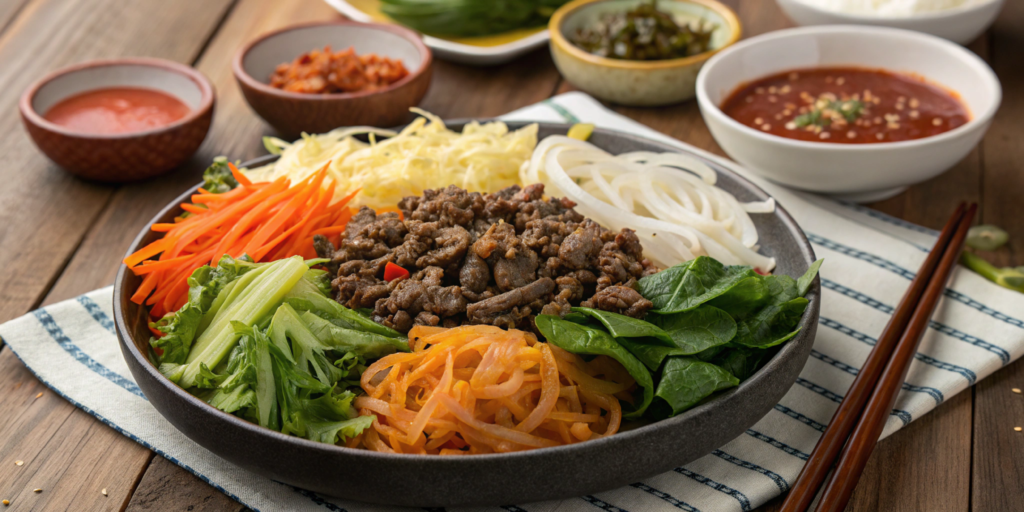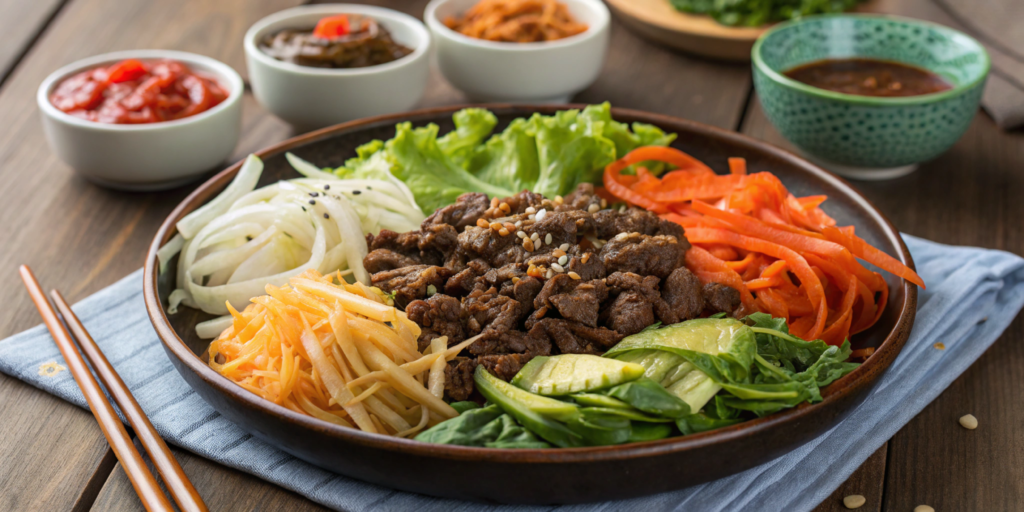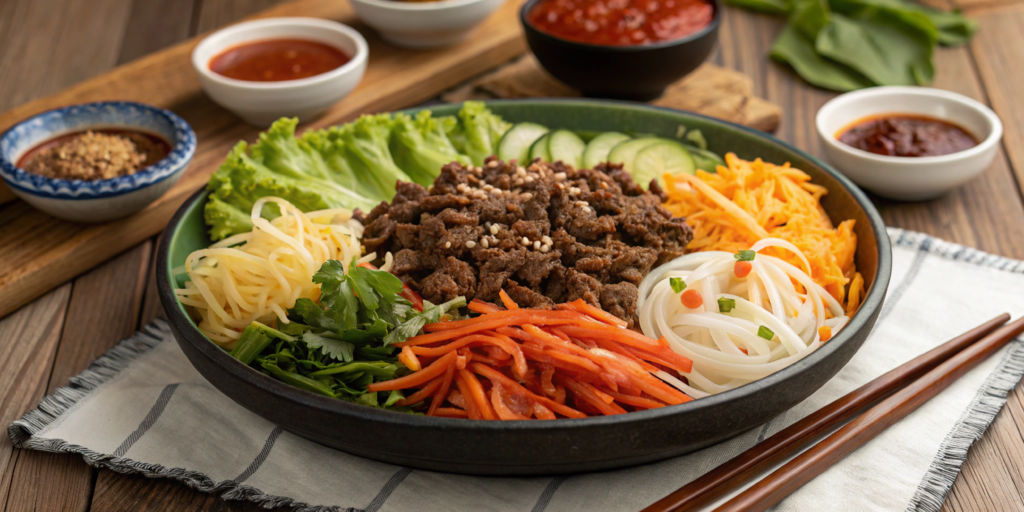Ground beef bulgogi is a delicious and versatile dish rooted in Korean cuisine. Known for its savory, slightly sweet, and umami-rich marinade, bulgogi has been a staple in Korean households for generations. While the dish is traditionally made with thinly sliced beef, the ground beef version offers a quicker, budget-friendly twist without sacrificing the signature flavors.
One of the best parts of enjoying ground beef bulgogi is pairing it with the perfect side dishes. From classic Korean banchan (side dishes) to creative, modern pairings, the right accompaniments can elevate your meal into a feast. Whether you’re hosting a dinner party or preparing a simple weeknight dinner, these side dishes add texture, flavor, and balance to your plate.
In this guide, we’ll explore traditional and modern sides, drink pairings, and tips for creating a well-rounded meal featuring ground beef bulgogi.

Traditional Korean Sides That Pair Perfectly with Ground Beef Bulgogi
Ground beef bulgogi shines brightest when accompanied by authentic Korean side dishes. These banchan (small side dishes) are integral to Korean cuisine, providing a variety of textures, flavors, and nutrients that complement the rich and savory notes of bulgogi. Here are some traditional pairings you’ll love:
Kimchi: A Classic Bulgogi Companion
No Korean meal is complete without kimchi. This tangy, spicy, and slightly sour fermented dish is made with napa cabbage, radish, or cucumber, seasoned with red pepper flakes, garlic, ginger, and fish sauce. Its bright acidity cuts through the richness of the bulgogi, creating a perfectly balanced bite.
Quick Tip: If you’re new to kimchi, try mild versions like white kimchi, which is less spicy but equally flavorful.
Japchae (Sweet Potato Noodles)
Japchae is a classic Korean dish made with glass noodles (dangmyeon) stir-fried with sesame oil, soy sauce, and a medley of vegetables like carrots, spinach, and mushrooms. Its subtly sweet and savory profile pairs harmoniously with the bold flavors of bulgogi.
Serving Idea: Plate japchae as a bed under the bulgogi or serve it on the side for guests to mix and match.
Korean Pancakes (Jeon)
Crispy on the outside and soft inside, jeon is a savory pancake made with ingredients like scallions, kimchi, or seafood. Popular types include pajeon (green onion pancake) and kimchi jeon. These make a fantastic pairing with bulgogi, adding a crispy, hearty element to the meal.
Pro Tip: Serve jeon with a simple dipping sauce made from soy sauce, vinegar, and sesame seeds for extra flavor.
Steamed White Rice or Mixed Grain Rice
Rice is a staple in Korean cuisine and the ultimate canvas for soaking up bulgogi’s flavorful marinade. While white rice is traditional, mixed grain rice (japgokbap), which combines rice with grains like barley and millet, offers a nutty flavor and added nutrients.
Serving Tip: Use a small bowl to mold the rice into neat portions for an appealing presentation.
Soybean Sprout Salad (Kongnamul Muchim)
This light and refreshing side dish is made by blanching soybean sprouts and tossing them in sesame oil, garlic, and a pinch of salt. It provides a crisp texture and subtle nuttiness that complements bulgogi beautifully.
These traditional sides celebrate the essence of Korean cuisine, creating a meal that feels both authentic and satisfying. Pair a few of these with ground beef bulgogi, and you’ll have a dinner that transports you straight to Seoul!
Creative Side Dish Ideas for savory bulgogi recipe
While traditional Korean side dishes are classics for a reason, adding a modern twist can bring new life to your ground beef bulgogi meal. These creative pairings are perfect for those looking to experiment or introduce a fusion of flavors to the table.
Fresh Lettuce Wraps: A Fun Way to Serve Bulgogi
This vibrant slaw combines shredded cabbage, carrots, and bell peppers with a tangy sesame-ginger dressing. The crunch of fresh vegetables and the zingy dressing provide a refreshing contrast to the warm and savory bulgogi.
Recipe Idea: Toss thinly sliced red onions and cilantro into your slaw for added depth and color.
Lettuce Wrap
Transform your ground beef bulgogi into an interactive dining experience by serving it with crisp lettuce leaves. Butter lettuce, romaine, or even Napa cabbage leaves work well. Add toppings like sliced cucumbers, julienned carrots, and ssamjang (a spicy Korean dipping sauce) to let guests build their wraps.
Pro Tip: For an added crunch, include crushed roasted peanuts or sesame seeds.
Roasted Vegetables with Korean-Inspired Flavors
Roasting vegetables like broccoli, carrots, and brussels sprouts with a glaze made from gochujang (Korean chili paste), soy sauce, honey, and sesame oil creates a flavorful, caramelized side dish. The slight heat from the glaze complements the savory sweetness of bulgogi.
Serving Idea: Roast the vegetables until slightly charred for an extra smoky flavor.
Kimchi Fried Rice
If you have leftover kimchi and rice, kimchi fried rice (kimchi bokkeumbap) is a must-try. This quick and easy dish combines the tangy, spicy flavors of kimchi with the heartiness of fried rice. Toss in a fried egg for a creamy topping that pairs perfectly with the bulgogi.
Quick Hack: Use day-old rice for the best texture in fried rice.
Gochujang Deviled Eggs
Deviled eggs get a spicy makeover with a dollop of gochujang mixed into the yolk filling. This unique appetizer adds a creamy yet bold kick to your table, making it an unexpected but delightful pairing with bulgogi.
Presentation Tip: Garnish each egg with a sprinkle of green onions or sesame seeds for a polished look.
Pickled Vegetables (Quick Pickles)
Quick-pickled radishes, cucumbers, or red onions bring a tangy brightness that cuts through the richness of bulgogi. They’re easy to prepare and add a pop of color to your meal.
Simple Recipe: Combine equal parts vinegar and water, add sugar and salt to taste, and let your vegetables sit for at least 30 minutes.
These modern pairings offer exciting ways to enjoy ground beef bulgogi while catering to a wide range of palates. Mix traditional and creative sides for a meal that’s both comforting and adventurous!
Drinks and Sauces to Complete Your Bulgogi Meal

A well-rounded meal isn’t just about the food; drinks and sauces play a key role in enhancing the flavors of ground beef bulgogi. Whether you’re hosting a dinner party or enjoying a casual meal, these accompaniments will take your bulgogi experience to the next level.
Drink Pairings
- Soju:
This Korean distilled spirit is a classic pairing for bulgogi. Its smooth, slightly sweet flavor balances the bold umami notes of the dish. Serve chilled for the best experience. - Makgeolli (Korean Rice Wine):
A traditional Korean rice wine with a slightly sweet, tangy, and fizzy profile, makgeolli pairs beautifully with the savory richness of bulgogi. Its creamy texture is also a great contrast to the meal’s textures. - Green Tea:
For a non-alcoholic option, green tea is a refreshing choice. The light bitterness of the tea cleanses the palate between bites, letting you fully enjoy each side dish. - Craft Beer:
A crisp, light beer complements the smoky, sweet flavors of bulgogi. Look for lagers or pale ales for an easy-drinking option.
Essential Dipping Sauces for Ground Beef Bulgogi
- Ssamjang (Korean Dipping Sauce):
Made with gochujang, doenjang (soybean paste), garlic, sesame oil, and honey, ssamjang is a must-have for lettuce wraps or as a bold condiment for bulgogi.
Quick Recipe: Mix 2 tablespoons of gochujang with 1 tablespoon of doenjang, 1 teaspoon of sesame oil, and a pinch of sugar for a quick and tasty sauce.
- Soy-Sesame Sauce:
A simple mix of soy sauce, sesame oil, and a touch of garlic creates a light and flavorful dipping sauce perfect for vegetables or pancakes. - Chili Garlic Oil:
For those who love heat, chili garlic oil adds a smoky, spicy kick that enhances every bite of bulgogi.
These drinks and sauces elevate the meal, ensuring every bite and sip feels perfectly balanced. They’re simple to prepare but make a big difference in creating a memorable dining experience.
Hosting a Ground Beef Bulgogi Dinner Party

Hosting a dinner party featuring ground beef bulgogi is a wonderful way to share a taste of Korean cuisine with friends and family. With a little planning, you can create an inviting and delicious experience that leaves your guests impressed and satisfied.
Plating and Presentation Tips
- Serve Family-Style: Arrange the bulgogi on a large platter surrounded by small bowls of banchan like kimchi, pickled vegetables, and soybean sprout salad. This encourages sharing and creates a communal atmosphere.
- Add a Touch of Elegance: Use small ramekins for sauces and colorful plates to highlight the vibrant ingredients. Garnish the bulgogi with sesame seeds and green onions for a polished look.
Building a Balanced Menu
A successful dinner party menu balances flavors, textures, and variety. Here’s an idea for a complete meal:
- Appetizer: Korean pancakes (jeon) or gochujang deviled eggs.
- Main Dish: Ground beef bulgogi, served with steamed rice or lettuce wraps.
- Side Dishes: Japchae, roasted vegetables with Korean glaze, and Asian-style slaw.
- Dessert: Sweet rice cakes (tteok) or fruit skewers drizzled with honey.
Creating the Ambiance
- Decor: Incorporate elements like bamboo placemats, chopsticks, and small floral arrangements for an authentic and cozy vibe.
- Music: Play soft Korean instrumental music in the background to set the tone without overpowering conversations.
With these tips, you’ll create a memorable meal that’s as enjoyable to eat as it is to prepare. Ground beef bulgogi is the star, but thoughtful details like presentation and ambiance make the entire experience special.
FAQs
Here are some common questions about serving ground beef bulgogi, answered to help you create the best dining experience:
What is the difference between ground beef bulgogi and regular bulgogi?
The primary difference lies in the cut of beef. Traditional bulgogi uses thinly sliced beef, such as ribeye, which is marinated and grilled. Ground beef bulgogi offers a quicker and more budget-friendly version, with the same flavorful marinade infusing the beef.
Can I make ground beef bulgogi gluten-free?
Absolutely! Substitute soy sauce with tamari or coconut aminos, and check that your gochujang (if used) is labeled gluten-free. Many modern brands offer gluten-free options.
What’s the best way to reheat ground beef bulgogi?
To maintain its juicy texture, reheat bulgogi in a skillet over medium heat, adding a splash of water or broth to prevent it from drying out. Avoid reheating in the microwave, as it can make the beef chewy.
Can I prepare side dishes ahead of time?
Yes! Many banchan, such as kimchi and japchae, can be made in advance and stored in the fridge. This allows you to focus on cooking and presenting the main dish on the day of your meal.
Conclusion
Ground beef bulgogi is a flavorful and versatile dish that shines brightest when paired with complementary side dishes, drinks, and sauces. From traditional Korean banchan like kimchi and japchae to creative modern twists like Asian-style slaw and roasted vegetables, the possibilities are endless. With thoughtful pairings, you can create a balanced and satisfying meal that delights your taste buds.
Whether you’re hosting a dinner party or enjoying a weeknight meal, these tips and recipes will help you elevate your dining experience. So, gather your ingredients, set the table, and enjoy the rich, delicious world of Korean cuisine!


2 thoughts on “Perfect Pairings: What to Serve with Ground Beef Bulgogi”